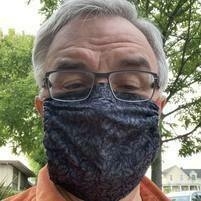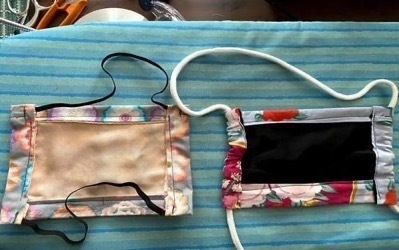Makin' Masks
New research shows that wearing masks makes a difference. But we all have to do it!
According to Science Daily, reporting on a study from the University of Cambridge:
The widespread use of face masks keeps the coronavirus reproduction number below 1.0, and prevents further waves when combined with lockdowns, new research suggests. A modeling study from the universities of Cambridge and Greenwich indicates that lockdowns alone will not stop the resurgence of COVID-19. Researchers say even homemade masks with limited effectiveness can dramatically reduce transmission rates if worn by enough people, regardless of whether they show symptoms.
I love making my own masks. I even bought a sewing machine to do it (the inexpensive Bernina Bernett b35, now sold out everywhere!) With a little practice you can make a mask like this:

It’s taken me a while to perfect this mask, but I love it because
- it’s relatively easy to make
- it’s convenient to wear and take off
- fit is snug and almost airtight
- it’s effective
I started with this video then made some improvements:
One of the nicest features of this mask is how you tie it. There’s one length of cord1 that goes around your neck and ties at the top of the head. It’s effectively a drawstring which helps fit the mask snugly as you tie it. The neck loop is handy because you can take off the mask but leave it hanging around your neck for quick donning.2
I’ve made some changes to the mask that makes it more comfortable and, I believe, more effective.
First the materials. In the video the designer recommends two layers with a filter pocket. I tried this using high-threadcount cotton for the outer layer 3 and old t-shirts for the inner layer. The t-shirts are soft and comfortable but the pouch opening hits right at the mouth and kind of bothers me. And adding a filter layer (I tried vacuum cleaner bags and paper towels) really reduces breathe-ability. This is key; if it’s not easy to breathe in a mask you won’t wear it.
After reading about research from the American Chemical Society about the effectiveness of various materials for mask making:
One layer of a tightly woven cotton sheet combined with two layers of polyester-spandex chiffon – a sheer fabric often used in evening gowns – filtered out the most aerosol particles (80-99%, depending on particle size), with performance close to that of an N95 mask material. Substituting the chiffon with natural silk or flannel, or simply using a cotton quilt with cotton-polyester batting, produced similar results.
I decided to eliminate the superfluous filter pouch and replace the t-shirt cotton with silk charmeuse. It feels better, it’s much easier to sew, and the breathe-ability is excellent. Come winter, and yes I expect us to still be wearing masks this winter, I’ll replace the silk with flannel.

To help seal the nose area I use peel and stick tin ties, the kind used to seal up coffee bags at the grocery store. I experimented with these by ripping them off all our coffee bags, but it turns out you can buy them by the hundred on Amazon, so no more open coffee bags at the Laporte house.
Sealing the nose well is important for mask effectiveness and to keep my glasses from steaming up. If I’m not wearing glasses I’m wearing protective lab goggles. Keeping the mouth, nose, and eyes protected from aerosolized virus particles is the goal here.
To soften the edges of the mask and block leaks around the edges, I have started folding all four edges in over a small strip of cotton quilt batting.

The batting adds some structure and softness to the edges and, as I learned when I used it as a layer in one of my masks, is practically impermeable. The mask on the left is for my mom. At 87-years-old she finds it hard to tie the string behind her head so I replaced it with elastic.
These masks are light, comfortable, and breathe-able. I don’t have any evidence that they’re more effective than any other mask, but I like to think so.
Want to make your own masks? Here’s what you need:
- Bernina Bernett b35
- Fiskar’s Sewing Essentials Kit
- Cotton Fabric
- Silk Charmeuse
- Cotton Clothesline Rope or Elastic Cord
- Peel-and-stick Tin Ties
- Cotton Quilt Batting
Make ‘em, wear ‘em and remember, I wear a mask to protect you; you wear a mask to protect me. :heart:
-
I use a 60 inch length of soft cotton clothesline rope. You can also use paracord or this really cool Bohemia ethnic thread a listener recommended. ↩︎
-
This freaks out some people because they figure the outer part of the mask might be covered with covid. But if it is, then so is my shirt, hair, etc. The trick is to keep the virus from your mouth, nose, and eyes. So wash your hands after you touch the mask. And if you’re that worried strip down when you get home and hop in the shower! These masks are not used the same way masks would be worn in a hospital. In a medical setting the mask is designed to protect the medical worker from an infected patient. We wear our masks to protect others from us. They also help keep us from touching our face when out and about. ↩︎
-
I use quilting fabric from Sewing Arts in Santa Monica. A fat-quarter bundle can make 40 masks and costs as little as $50. The patterns are really nice, too. ↩︎